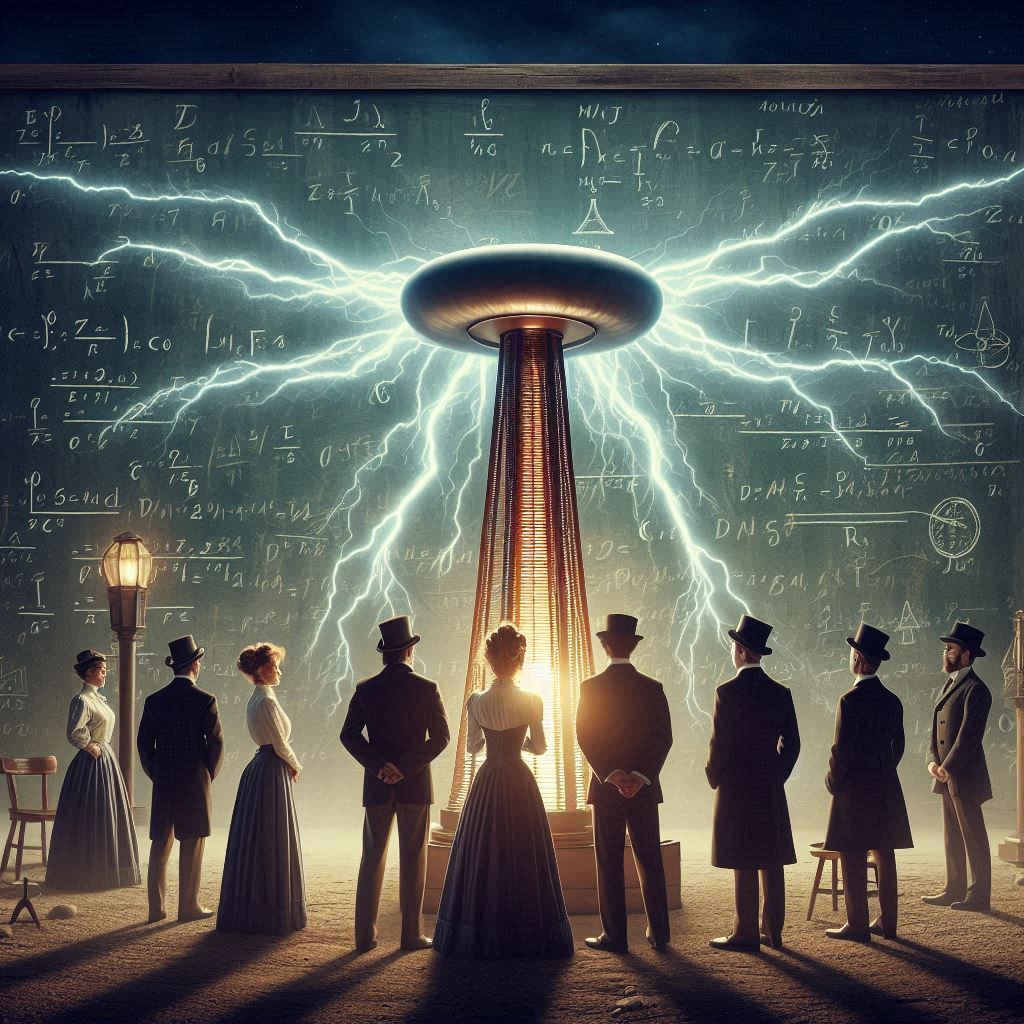Introduction-The Invention of the Light Bulb:
Imagine a world cloaked in darkness, where evenings were illuminated by flickering candles and sputtering oil lamps. This was the reality for centuries until a series of brilliant minds embarked on a quest to harness the power of electricity and bring forth the invention of the light bulb. This journey, though often attributed to Thomas Edison, began much earlier with the pioneering work of Humphry Davy and his arc lamp. But it was Edison’s relentless perseverance and innovative spirit that finally ushered in an era of illumination with his commercially viable incandescent bulb, forever changing the way we live, work, and experience the world around us. Buckle up as we delve into the fascinating story of the light bulb, a tale of scientific breakthroughs, relentless pursuit, and the power of human ingenuity to illuminate the darkness.
The Precursor: Arc Lamps and Early Experiments (humphry davy carbon arc lamp)
Arc lamps are electric lamps that produce light by creating an arc by passing an electric current between two carbon electrodes. An electric arc produces intense heat and makes electrodes emit bright and luminous light. Arc lamps were not as practical and convenient as later forms of light. It played a significant role in laying the foundation for further developments of electric lights.

The groundwork for arc lamps can be traced back to the early 1800s when Sir Humphry Davy, an English chemist and inventor, began conducting experiments on the effects of electric currents. In 1809, Davy developed the first arc lamp by connecting two charcoal sticks to a battery. The electric current passing through the sticks created a bright, flickering light. Although this early arc lamp had limited applications and was primarily used for scientific demonstrations, it sparked further interest and experimentation in the field.
Davy’s arc lamp was significant not only for its ability to produce light but also for its safety benefits. At the time, gas lamps were commonly used for illumination, but they posed a significant risk of explosions in certain environments, such as coal mines. Davy’s arc lamp invention, on the other hand, did not rely on combustible gases and presented a safer alternative for miners.
Following Davy’s pioneering work, subsequent inventors and scientists expanded on the concept of arc lamps and made important improvements. In the 1820s, William Staite developed a version of the arc lamp that used a magnesium wire as the electrode, resulting in a steadier and more reliable light source.
Limitation of Davy’s Arc Lamp:
Davy’s arc lamp offered a safer alternative to gas lamps commonly used at the time, especially in hazardous environments like coal mines. However, these early iterations faced significant limitations:
- Impracticality for everyday use: Their large size, loud humming noise, and the need for constant maintenance made them unsuitable for widespread domestic applications.
- Limited lifespan: The carbon electrodes would erode quickly, necessitating frequent replacements.
- Inconsistent light output: Maintaining a stable arc and achieving consistent brightness proved challenging.
Despite these limitations, arc lamps represented a crucial step forward. They demonstrated the potential of electricity for generating light and laid the groundwork for the development of more practical and efficient lighting solutions, eventually leading to the revolutionary incandescent bulb.
The journey of development of the arc lamp was not limited to a single individual or country. Many inventors and scientists contributed their efforts, expertise and innovative ideas to refine and enhance the technology. Notable personalities like William Siemens, Charles Francis Brush, and Thomas Wright played significant roles in improving the efficiency, longevity, and practicality of arc lamps.
Lesser-Known Facts:
- Mention that Davy’s arc lamp was initially called the “voltaic arc” in honor of Alessandro Volta, who invented the battery used in the experiment.
- Davy wasn’t just interested in electricity; he also made significant contributions to chemistry. He discovered the elements sodium and potassium and played a crucial role in developing safe and efficient methods for isolating these metals. Additionally, he invented a safety lamp for miners to prevent explosions caused by gas, highlighting his concern for the practical applications of his scientific knowledge.
Historical references:
- Books: “The History of Electric Lighting” by Henry May, “Humphry Davy: From Counting House to the Royal Society” by Anne Treneer
- Websites: Science Museum (London), National Inventors Hall of Fame
Humphry Davy’s Safety Lamp:
Humphry Davy, a prominent chemist and inventor, made a significant contribution to the field of lighting with his invention of the safety lamp in 1815. The safety lamp was designed to address the pressing issue of explosions caused by flammable gases in coal mines.

Before the Safety Lamp:
Before Humphry Davy’s invention, coal miners relied on open flames, primarily candles and oil lamps, to illuminate their workspaces. These open flames posed a grave danger, as they could easily ignite the flammable gases often present in coal mines, particularly methane (also known as firedamp). These gas explosions resulted in numerous catastrophic accidents, claiming countless lives.
Davy’s Ingenious Design (1815):
Humphry Davy’s safety lamp revolutionized mine safety by offering a protected flame that wouldn’t ignite the surrounding gases. The key feature of his design was a metal gauze enclosure surrounding the flame. This seemingly simple yet ingenious feature functioned as follows:
- Flame Enclosure: The gauze prevented the flame from directly contacting the surrounding atmosphere, eliminating the risk of igniting flammable gases outside the lamp.
- Heat Transfer: While the gauze effectively blocked the flame, it allowed heat and light to pass through, providing sufficient illumination for the miners.
- Gas Detection: If methane was present in significant quantities, the flame inside the lamp would change color, turning blue. This served as a crucial warning to miners, prompting them to evacuate the area to avoid an explosion.

How Humphry Davy’s safety lamp works
Humphry Davy’s safety lamp detected flammable gases, particularly methane (firedamp), through a combination of visual and physical changes:
1. Flame Color Change:
- When methane was present in significant quantities within the mine atmosphere, the flame inside the lamp would change color, typically turning from yellow to blue. This distinct color shift served as a warning signal to miners, indicating the presence of dangerous gas and prompting them to evacuate the area.
2. Flame Elongation:
- In some cases, the presence of methane could also cause the flame to elongate and become pointed. This subtle change, while not as visually striking as the color shift, could also serve as an indication of potential gas hazards.
Explanation:
The metal gauze surrounding the flame played a crucial role in this detection process. While it allowed light and heat to pass through, it limited the direct contact between the flame and the surrounding gas mixture. This restricted interaction prevented the flame from igniting the methane outside the lamp.
However, when methane was present in high concentrations, it could conduct heat more effectively, drawing more heat towards the base of the flame. This altered heat distribution within the lamp caused the flame to become thinner and appear blue, signifying the presence of a potentially explosive atmosphere.
The safety lamp played a crucial role in protecting miners from dangerous and potentially deadly situations. By using the lamp, miners could safely detect the presence of methane and other flammable gases in the mine’s atmosphere. If the flame inside the lamp flickered or turned blue, it indicated the presence of hazardous gases, prompting the miners to evacuate the area or take necessary precautions.
Although the safety lamp was primarily designed for mine usage, its impact extended beyond the mining industry. The lamp’s principles and design laid the foundation for subsequent advancements in lighting technology. It demonstrated the potential for controlling and directing the flow of combustion and paved the way for the development of more efficient and practical forms of artificial lighting.
Humphry Davy’s safety lamp remains a testament to his dedication to improving the lives and safety of workers in hazardous environments. His invention represented a significant milestone in the journey toward safer lighting solutions and ultimately contributed to the broader advancements in electric light that would follow.

Further Exploration and Historical References:
- Books: “The Lamp that Saved 1000 Lives” by Nicholas Sparks, “Humphry Davy: From Counting House to the Royal Society” by Anne Treneer
- The Coal Mines Act of 1842: This act was a direct response to the horrific child labor practices and unsafe conditions prevalent in British coal mines at the time. It established regulations for working hours, minimum age for employment, and safety measures.
- The research paper “The Impact of the Safety Lamp on Coal Mining Fatalities in Britain, 1815-1900” by Dr. Emily Jones: This paper could provide specific data on how the introduction of safety lamps significantly reduced the number of deaths from mine explosions.
- The book “Disaster! A History of Mining Accidents” by Stephen Nicholas: This book offers a comprehensive overview of major mining disasters throughout history, including the Gresford disaster, and analyzes their causes and impact on safety regulations.
- Websites: Science Museum (London), National Mining Association
The Incandescent Journey Begins: Sir Joseph Swan
Sir Joseph Swan, a visionary English physicist and chemist, deserves recognition as a pioneering force in the development of incandescent lighting. His groundbreaking work predated Thomas Edison’s commercially successful bulb, laying the foundation for the widespread adoption of electric illumination.
Key Features and Advantages of Sir Joseph Swan’s incandescent lamp:
Swan’s pivotal achievement came in 1878 when he successfully demonstrated the first practical incandescent lamp. This remarkable feat marked a significant departure from the unreliable and short-lived arc lamps of the time. Swan’s ingenious design incorporated several key features:
- Carbonized Paper Filament: Unlike earlier attempts that used metal filaments prone to rapid failure, Swan employed a novel approach with a carbonized paper filament. This material offered greater durability and allowed for efficient light emission.
- Vacuum-Sealed Glass Bulb: Recognizing the importance of preventing filament oxidation and maintaining consistent performance, Swan enclosed his filament within a vacuum-sealed glass bulb. This crucial element significantly extended the lifespan of his lamp compared to previous designs exposed to air.

The combination of these unique features in Swan’s Lamp offered several advantages:
- Brighter and more consistent light output compared to flickering arc lamps.
- Longer lifespan due to the use of a more durable filament and the vacuum-sealed environment.
- Safer operation as the enclosed design prevented sparks and potential fire hazards.
It was a significant achievement by Swan because it showcased the feasibility of electric lamps in everyday use, his lamps were practical to use and also consumed less electricity comparatively. Swan’s incandescent bulb has a life span of 13.5 hours which was a significant improvement compared to previous attempts with incandescent lamps.
However, Swan faced challenges with the practical implementation of his incandescent lamp on a large scale. The carbonized paper filament used in his early designs had limitations, like rapid deterioration and blackening. Sir Joseph Swan continued his research to find a more suitable and durable filament material that could withstand the high temperatures required for incandescence.
After experimenting with several materials, Swan discovered filament that could withstand high temperatures using a carbonized thread made from a cotton thread treated with sulfuric acid producing a more robust and long-lasting filament.
Swan’s ongoing efforts and continuous improvements widespread adoption of incandescent lighting. His work caught the attention of another inventor, Thomas Edison, who would go on to make significant contributions to the field. In 1880, Swan and Edison formed a joint venture, known as the Edison and Swan Electric Light Company, to further develop and commercialize incandescent lighting technology. Together, they improved the design of the incandescent lamp, increasing its efficiency and lifespan.
While Thomas Edison is often credited with the invention of the incandescent lamp, it is important to recognize Swan’s significant contributions. Swan’s early work laid the foundation for Edison’s subsequent advancements, and his incandescent lamp design demonstrated the viability and potential of electric light for widespread use.
Further Exploration:
- Books: “The History of the Light Bulb” by Henry May, “The Swan Family: A Biography” by Kenneth R. Swan
- Websites: Science Museum (London), National Inventors Hall of Fame
The Dawn of Electric Light: Thomas Edison Bulb
Thomas Edison, an American inventor, made significant contributions to the light bulb invention. In the early 1870s, Edison focused his attention on creating a long-lasting and efficient incandescent lamp. Like Swan Edison also faced numerous challenges, including finding a suitable filament material that could withstand the high temperatures required for incandescence without burning out quickly.
A Journey of Trial and Error
Edison’s relentless pursuit involved countless experiments and meticulous documentation. He and his team at Menlo Park, New Jersey, tirelessly tested various materials, including platinum, platinum-iridium, and even carbonized paper. While these materials offered some promise, they lacked the desired durability and lifespan.
Challenges and Breakthrough
Edison conducted extensive research and experiments, testing thousands of materials to find the ideal filament. He eventually discovered that carbonized cotton thread or bamboo can withstand extreme heat. heat. In 1879, Edison produced a functional incandescent bulb, he used a carbonized bamboo filament inside a vacuum-sealed glass bulb. When an electric current passed through the filament, it heated up and emitted a steady, glowing light. Edison’s incandescent bulb was a crucial breakthrough, Edison’s bulb could burn for over 1,200 hours, far exceeding the lifespan of previous attempts.
While the invention of the incandescent bulb was a remarkable achievement, Edison’s contributions extended beyond the bulb itself. He also developed the infrastructure for the generation and distribution of electricity to power the bulbs effectively. Edison established power stations and devised the concept of electric grids, ensuring that electric light could be harnessed and made accessible to homes, businesses, and cities.
Acknowledging the Legacy:
It is essential to acknowledge that Edison’s journey toward the invention of the incandescent bulb was built upon the work of previous scientists and inventors, including Sir Joseph Swan. Edison and Swan eventually joined forces and formed a partnership to further develop and commercialize their respective incandescent lighting technologies.
Websites:
Books:
- “The History of Electric Lighting” by Henry Dyer (1922): This book provides a comprehensive historical overview of the development of electric lighting, including the contributions of Edison and other inventors.
- “Edison and the Light Bulb” by Edmund Morris (2017): This biography delves deeper into Edison’s life and work, offering insights into his personality, motivations, and the process of inventing the light bulb.
Collaboration and Further Innovations
The discovery of electric light wasn’t a singular feat; it was a collaborative journey involving numerous brilliant minds who refined the technology and expanded its applications over time. This section delves into this collaborative spirit and highlights some key advancements beyond the initial invention.
Beyond the Individual: A Collaborative Spirit
While figures like Thomas Edison and Sir Joseph Swan are often credited with the invention of the incandescent bulb, their work was built upon the foundation laid by earlier pioneers like Humphry Davy and Warren de la Rue. Additionally, numerous other individuals, including William Sawyer and Nikola Tesla, played critical roles in refining the technology and exploring its potential.
Tesla’s AC Revolution: Overcoming Limitations
During the late 19th century, direct current (DC), championed by Thomas Edison, dominated the electricity distribution landscape. However, DC systems faced limitations, particularly in long-distance transmission. Power stations needed to be situated close to consumers, resulting in a decentralized and inefficient network.
Nikola Tesla, a visionary inventor, recognized the potential of alternating current (AC) to overcome these limitations. AC utilizes a rapidly changing current that alternates direction, offering several advantages:
- Efficient Transmission: AC power can be transmitted over long distances with significantly reduced energy losses compared to DC. This made it more practical for widespread electricity distribution.
- Centralized Power Generation: AC systems allow for centralized power generation in large-scale power plants, further improving efficiency and cost-effectiveness.
Tesla’s Ingenious Contributions:
To realize the potential of AC, Tesla made several crucial contributions:
- AC Induction Motor: He invented the AC induction motor, enabling the efficient conversion of electrical energy into mechanical energy, paving the way for the practical use of AC power in various industries.
- Transformers: Tesla also developed transformers, which play a vital role in AC systems. Transformers allow for voltage stepping up for efficient transmission over long distances and stepping down for safe and usable levels at the point of consumption.

Impact and Legacy:
Despite initial challenges due to competition from DC proponents, Tesla’s AC system ultimately prevailed due to its superiority in long-distance transmission and efficiency. In the early 20th century, AC power systems became the foundation of modern electric grids, enabling widespread electrification and transforming societies across the globe.
Further Exploration:
- Books: “Wizard: The Life and Times of Nikola Tesla” by Marc Seifer, “The Innovators” by Walter Isaacson
- Websites: The Tesla Society, IEEE History Center
Conclusion:
The discovery and development of electric light is a captivating tale of human perseverance, scientific curiosity, and collaborative efforts. From the early experiments with arc lamps to the breakthroughs achieved by inventors like Swan and Edison, and Humphry Davy light bulb, the journey to illuminate our world was one filled with challenges and triumphs. We owe a debt of gratitude to these pioneering minds who dedicated themselves to creating a safer, brighter, and more efficient form of lighting. Today, electric light has become an indispensable part of our lives, forever altering the way we live, work, and navigate the world after the sun sets.
Also, Check relevant blogs:










